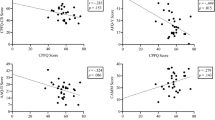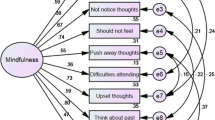Abstract
Objectives
The present study examines the correspondence between the Children’s Psychological Flexibility Questionnaire (CPFQ) and three commonly used psychological flexibility measures between a sample of neurotypical children and adults.
Methods
One hundred and one children and 106 adults completed the CPFQ, Child and Adolescent Mindfulness Measure (CAMM), Avoidance and Fusion Questionnaire-Youth (AFQ-Y), and the Acceptance and Action Questionnaire-II (AAQ-II), and results were compared within and between age groups.
Results
Correlations between scores on each measure were computed and yielded statistically significant correlations between the CPFQ and the CAMM (r = .553, p < .001), the AFQ-Y (r = − .646, p < .001), and the AAQ-II (r = − .563, p < .001).
Conclusion
The obtained measures of CPFQ suggest that the measure is appropriate for use with children and adult populations. The findings are consistent with patterns observed on established measures, establishing convergent validity among investigated measures. Implications for the age appropriateness of the language used on CPFQ and the CPFQ’s clinical utility are discussed.



Similar content being viewed by others
Data Availability
The data that support the findings of this study are available from the second author, JMH (jhinma2@uic.edu), upon reasonable request.
References
Bachmann, K., Hinman, J. M., Yi, Z., & Dixon, M. R. (2021). Evaluating the convergent and divergent validity of the Children’s Psychological Flexibility Questionnaire (CPFQ) among children with autism. Advances in Neurodevelopmental Disorders, 1-6. https://doi.org/10.1007/s41252-021-00206-w
Beck, A. T., Ward, C. H., Mendelson, M., Mock, J., & Erbaugh, J. (1961). An inventory for measuring depression. Archives of General Psychiatry, 4(6), 561–571. https://doi.org/10.1001/archpsyc.1961.01710120031004
Bernal-Manrique, K. N., García-Martín, M. B., & Ruiz, F. J. (2020). Effect of acceptance and commitment therapy in improving interpersonal skills in adolescents: A randomized waitlist control trial. Journal of Contextual Behavioral Science, 17, 86–94. https://doi.org/10.1016/j.jcbs.2020.06.008
Bitsko, R. H., Holbrook, J. R., Ghandour, R. M., Blumberg, S. J., Visser, S. N., Perou, R., & Walkup, J. T. (2018). Epidemiology and impact of health care provider–diagnosed anxiety and depression among US children. Journal of Developmental and Behavioral Pediatrics, 39(5), 395–403. https://doi.org/10.1097/DBP.0000000000000571
Bond, F. W., Hayes, S. C., Baer, R. A., Carpenter, K. M., Guenole, N., Orcutt, H. K., Waltz, T., & Zettle, R. D. (2011). Preliminary psychometric properties of the Acceptance and Action Questionnaire–II: A revised measure of psychological inflexibility and experiential avoidance. Behavior Therapy, 42(4), 676–688. https://doi.org/10.1016/j.beth.2011.03.007
Cashel, M. L. (2002). Child and adolescent psychological assessment: Current clinical practices and the impact of managed care. Professional Psychology: Research and Practice, 33(5), 446. https://doi.org/10.1037/0735-7028.33.5.446
Dixon, M. R., & Paliliunas, D. (2018). Accept. Identify. Move: A behavior analytic curriculum for social-emotional development in children. Shawnee Scientific Press. Carbondale, IL
Fledderus, M., Bohlmeijer, E. T., Smit, F., & Westerhof, G. J. (2010). Mental health promotion as a new goal in public mental health care: A randomized controlled trial of an intervention enhancing psychological flexibility. American Journal of Public Health, 100(12), 2372–2372. https://doi.org/10.2105/AJPH.2010.196196)
Greco, L. A., Baer, R. A., & Smith, G. T. (2011). Assessing mindfulness in children and adolescents: Development and validation of the Child and Adolescent Mindfulness Measure (CAMM). Psychological Assessment, 23(3), 606. https://doi.org/10.1037/a0022819
Greco, L. A., Lambert, W., & Baer, R. A. (2008). Psychological inflexibility in childhood and adolescence: Development and evaluation of the Avoidance and Fusion Questionnaire for Youth. Psychological Assessment, 20(2), 93. https://doi.org/10.1037/1040-3590.20.2.93
Guerra, J., García-Gómez, M., Turanzas, J., Cordón, J. R., Suárez-Jurado, C., & Mestre, J. M. (2019). A brief Spanish version of the Child and Adolescent Mindfulness Measure (CAMM). A dispositional mindfulness measure. International Journal of Environmental Research and Public Health, 16(8), 1355–1367. https://doi.org/10.3390/ijerph16081355
Hayes, S. C., Luoma, J. B., Bond, F. W., Masuda, A., & Lillis, J. (2006). Acceptance and commitment therapy: Model, processes and outcomes. Behaviour Research and Therapy, 44(1), 1–25. https://doi.org/10.1016/j.brat.2005.06.006
Hayes, S. C., Strosahl, K., Wilson, K. G., Bissett, R. T., Pistorello, J., Toarmino, D., Polusny, M. A., Dykstra, T. A., Batten, S. V., & Bergan, J. (2004). Measuring experiential avoidance: A preliminary test of a working model. The Psychological Record, 54(4), 553–578. https://doi.org/10.1007/BF03395492
Hayes, S. C., Strosahl, K. D., & Wilson, K. G. (2011). Acceptance and commitment therapy: The process and practice of mindful change. Guilford Press
Hays, R. D., Morales, L. S., & Reise, S. P. (2000). Item response theory and health outcomes measurement in the 21st century. Medical Care, 38(28). https://doi.org/10.1097/00005650-200009002-00007
Holahan, C. J., & Moos, R. H. (1987). Risk, resistance, and psychological distress: A longitudinal analysis with adults and children. Journal of Abnormal Psychology, 96(1), 3. https://doi.org/10.1037/0021-843X.96.1.3
Kalmakis, K. A., & Chandler, G. E. (2014). Adverse childhood experiences: Towards a clear conceptual meaning. Journal of Advanced Nursing, 70(7), 1489–1501. https://doi.org/10.1111/jan.12329
Kamphaus, R., Petoskey, M. D., & Rowe, E. W. (2000). Current trends in psychological testing of children. Professional Psychology: Research and Practice, 31(2), 155. https://doi.org/10.1037/0735-7028.31.2.155
Kovacs, M. (2010). Children’s depression inventory 2. Pearson Assessments.
Kuby, A. K., McLean, N., & Allen, K. (2015). Validation of the Child and Adolescent Mindfulness Measure (CAMM) with non-clinical adolescents. Mindfulness, 6(6), 1448–1455. https://doi.org/10.1007/s12671-015-0418-3
Lappalainen, R., Lappalainen, P., Puolakanaho, A., Hirvonen, R., Eklund, K., Ahonen, T., Muotka, J., & Kiuru, N. (2021). The Youth Compass-The effectiveness of an online acceptance and commitment therapy program to promote adolescent mental health: A randomized controlled trial. Journal of Contextual Behavioral Science, 20, 1–12. https://doi.org/10.1016/j.jcbs.2021.01.007
Livheim, F., Tengström, A., Andersson, G., Dahl, J., Björck, C., & Rosendahl, I. (2020). A quasi-experimental, multicenter study of acceptance and commitment therapy for antisocial youth in residential care. Journal of Contextual Behavioral Science, 16, 119–127. https://doi.org/10.1016/j.jcbs.2020.03.008
Merikangas, K. R., He, J.-P., Burstein, M., Swanson, S. A., Avenevoli, S., Cui, L., Benjet, C., Georgiades, K., & Swendsen, J. (2010). Lifetime prevalence of mental disorders in US adolescents: Results from the National Comorbidity Survey Replication-Adolescent Supplement (NCS-A). Journal of the American Academy of Child & Adolescent Psychiatry, 49(10), 980–989. https://doi.org/10.1016/j.jaac.2010.05.017
Millon, T., Tringone, R., Grossman, S., & Millon, C. (2020). Millon adolescent clinical inventory-II (MACI-II). Pearson Assessments.
Muris, P., Meesters, C., Herings, A., Jansen, M., Vossen, C., & Kersten, P. (2017). Inflexible youngsters: Psychological and psychopathological correlates of the Avoidance and Fusion Questionnaire for youths in nonclinical Dutch adolescents. Mindfulness, 8(5), 1381–1392. https://doi.org/10.1007/s12671-017-0714-1
Ong, C. W., Lee, E. B., Levin, M. E., & Twohig, M. P. (2019). A review of AAQ variants and other context-specific measures of psychological flexibility. Journal of Contextual Behavioral Science, 12, 329–346. https://doi.org/10.1016/j.jcbs.2019.02.007
Pennato, T., Berrocal, C., Bernini, O., & Rivas, T. (2013). Italian version of the Acceptance and Action Questionnaire-II (AAQ-II): Dimensionality, reliability, convergent and criterion validity. Journal of Psychopathology and Behavioral Assessment, 35(4), 552–563. https://doi.org/10.1007/s10862-013-9355-4
Pinto-Gouveia, J., Gregório, S., Dinis, A., & Xavier, A. (2012). Experiential avoidance in clinical and non-clinical samples: AAQ-II Portuguese version. International Journal of Psychology and Psychological Therapy, 12(2), 139–156.
Prenoveau, J. M., Papadakis, A. A., Schmitz, J., Hirsch, E. L., Dariotis, J. K., & Mendelson, T. (2018). Psychometric properties of the Child and Adolescent Mindfulness Measure (CAMM) in racial minority adolescents from low-income environments. Psychological Assessment, 30(10), 1395. https://doi.org/10.1037/pas0000630
Punna, M., Lappalainen, R., Kettunen, T., Lappalainen, P., Muotka, J., Kaipainen, K., Villberg, J., & Kasila, K. (2021). Can peer-tutored psychological flexibility training facilitate physical activity among adults with overweight? Journal of Contextual Behavioral Science, 21, 1–11. https://doi.org/10.1016/j.jcbs.2021.04.007
Reynolds, C. R., & Richmond, B. O. (2008). Revised children’s manifest anxiety scale, second edition (RCMAS-2). Western Psychological Services.
Roux, B., Franckx, A.-C., Lahaye, M., Deplus, S., & Philippot, P. (2019). A French validation of the child and adolescent mindfulness measure (CAMM). European Review of Applied Psychology, 69(3), 83–89. https://doi.org/10.1016/j.erap.2019.06.001
Saggino, A., Bartoccini, A., Sergi, M. R., Romanelli, R., Macchia, A., & Tommasi, M. (2017). Assessing mindfulness on samples of Italian children and adolescents: The validation of the Italian version of the child and adolescent mindfulness measure. Mindfulness, 8(5), 1364–1372. https://doi.org/10.1007/s12671-017-0712-3
Valdivia-Salas, S., Martín-Albo, J., Zaldivar, P., Lombas, A. S., & Jiménez, T. I. (2017). Spanish validation of the Avoidance and Fusion Questionnaire for Youth (AFQ-Y). Assessment, 24(7), 919–931. https://doi.org/10.1177/1073191116632338
Yavuz, F., Ulusoy, S., Iskin, M., Esen, F. B., Burhan, H. S., Karadere, M. E., & Yavuz, N. (2016). Turkish version of Acceptance and Action Questionnaire-II (AAQ-II): A reliability and validity analysis in clinical and non-clinical samples. Klinik Psikofarmakoloji Bülteni-Bulletin of Clinical Psychopharmacology, 26(4), 397–408. https://doi.org/10.5455/bcp.20160223124107
Author information
Authors and Affiliations
Contributions
CL: conducted research, recruited participants, and helped analyze the data. JMH: helped develop the methods of the study, analyzed the data, and wrote parts of the paper. ZY: conducted data analysis and wrote parts of the paper. MRD: developed the methods of the study and collaborated in the writing and editing of the final manuscript.
Corresponding author
Ethics declarations
Ethics Approval
All procedures performed in studies involving human participants were in accordance with the ethical standards of the institutional research committee and with the 1964 Helsinki Declaration and its later amendments or comparable ethical standards. Research was conducted when all authors were afflicted with Southern Illinois University. The Human Subject Committee approved the study at Southern Illinois University (Protocol number 19266).
Informed Consent
Consent was obtained for all participants. Assent was obtained by the parents of all participants under the age of 18.
Conflict of Interest
Mark R. Dixon receives small royalties from the book that the CPFQ originally published. The CPFQ in its entirety is available free online at https://www.acceptidentifymove.com. The remaining authors declare no competing interests.
Additional information
Publisher's Note
Springer Nature remains neutral with regard to jurisdictional claims in published maps and institutional affiliations.
Rights and permissions
About this article
Cite this article
Lenoir, C., Hinman, J.M., Yi, Z. et al. Further Examination of the Children’s Psychological Flexibility Questionnaire (CPFQ): Convergent Validity and Age Appropriateness. Adv Neurodev Disord 6, 224–233 (2022). https://doi.org/10.1007/s41252-022-00259-5
Accepted:
Published:
Issue Date:
DOI: https://doi.org/10.1007/s41252-022-00259-5




